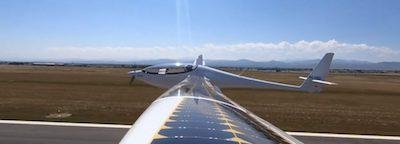Wed, Aug 22, 2018
Aircraft A Prototype For Commercial And Government Security Missions
Bye Aerospace has announced the successful completion of the first flight of the solar electric technology demonstrator prototype for its “StratoAirNet” and “Solesa” families of medium-altitude aircraft systems. The piloted prototype first flight and subsequent flight tests took place at Northern Colorado Regional Airport, north of Loveland.

George E. Bye, CEO and Founder of Bye Aerospace, described the first flight as a significant industry milestone. “It was a great day for solar-electric aviation,” he said. “My thanks to our entire team for their persistence and extra efforts to achieve this milestone. I would also like to thank the professionals at Northern Colorado Regional Airport for their cooperation in making these flights possible.”
The Solesa and StratoAirNet family of aircraft systems is intended to provide support for long-endurance commercial and government security requirements, including patrol, observation, utility, mapping, precision agriculture, search and rescue and surveillance missions. The Solesa aircraft system will be piloted, performing similar patrol and survey missions for shorter flight durations. It also provides an R&D test platform for new customer payloads. StratoAirNet is intended to be a longer-endurance UAV and will follow required steps to qualify this additional capability.
Both StratoAirNet and Solesa offer unique advantages over traditional systems, including lower unit cost, lower heat and noise signatures, lower operating costs and enhanced utility. Bye Aerospace is collaborating with SolAero, integrating their advanced high-efficiency solar cell technologies on the advanced graphite composite wing.
Bye Aerospace completed the first flight of its “Sun Flyer 2” aircraft in April. The Sun Flyer family of aircraft aims to be the first FAA-certified, U.S.-sponsored, practical, all-electric airplanes to serve the flight training and general aviation markets. The company is collaborating with Siemens on the electric propulsion system for Sun Flyer 2.
(Image provided with Bye Aerospace news release)
More News
Its Offerings Are Lighter, Cleaner, and Now Pushing Past 1,000nm on SAF Jet Fuel DeltaHawk’s diesel-powered aircraft lineup has seen incredible upgrades over the last few yea>[...]
The Airplane Experienced A Total Loss Of Engine Power On December 3, 2025, about 1600 central standard time, a Mooney Aircraft Corp. M20K, N57229, was substantially damaged when it>[...]
Make Sure You NEVER Miss A New Story From Aero-News Network Do you ever feel like you never see posts from a certain person or page on Facebook or Instagram? Here’s how you c>[...]
Aero Linx: European Society of Aerospace Medicine (ESAM) As a pan-European, independent forum, it works to promote the safety and health of all persons involved in aviation and spa>[...]
“We are excited to see Wisk achieve this milestone, and I’m so proud of the team that made it possible. The team at Wisk has built advanced technologies across flight c>[...]
 Aero-TV: DeltaHawks Diesel Power Steps Into the Spotlight
Aero-TV: DeltaHawks Diesel Power Steps Into the Spotlight NTSB Prelim: Mooney Aircraft Corp. M20K
NTSB Prelim: Mooney Aircraft Corp. M20K ANN FAQ: Turn On Post Notifications
ANN FAQ: Turn On Post Notifications ANN's Daily Aero-Linx (12.20.25)
ANN's Daily Aero-Linx (12.20.25) Aero-News: Quote of the Day (12.20.25)
Aero-News: Quote of the Day (12.20.25)



